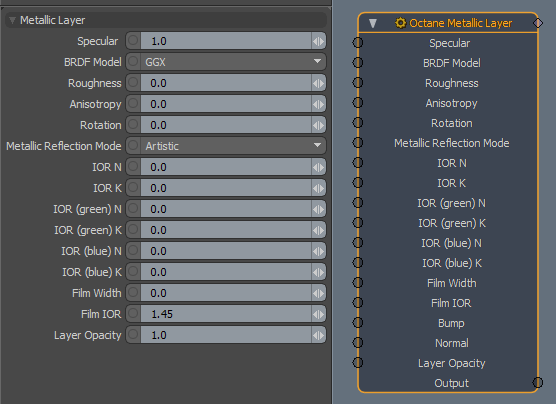
The Metallic Layer is used for highly reflective materials that have colored reflections. For more information, see the Metallic MaterialThe representation of the surface or volume properties of an object. topic in this manual.


SpecularAmount of specular reflection, or the mirror-like reflection of light photons at the same angle. Used for transparent materials such as glass and water. - The layer's coating color.
BRDF Model - Determines how light reflects or refracts. See BRDF Models for details.
Roughness - The Metallic layer's roughness.
Anisotropy - The Metallic layer's anisotropy. A value of -1 is horizontal, while 1 is vertical. A value of 0 is Isotropic.
Rotation - The Metallic Anisotropic reflection's rotation.
Metallic Reflection Mode - Changes how reflectivity is calculated. By default, reflections use Schlick's Approximation for the Fresnel effect. For a more physically accurate falloff, you can enter a complex IOR (N/K values):
Artistic - Uses the specular color.
IOR + Color - Uses the specular color and adjusts the brightness using the IOR.
RGB IOR - Uses the three IOR values for 650, 550, and 450 nm, and ignores the specular color.
IOR N/K - Complex-valued Index Of Refraction (n-k*i), which controls the Fresnel effect of the layer's specular reflection. For RGB mode, this serves as the Index Of Refraction for the red light (650nm).
IOR (Green) N/K - For RGB mode, this is the Index Of Refraction for the green light (550nm).
IOR (Blue) N/K - For RGB mode, this is the Index Of Refraction for the blue light (450nm).
Film Width - Sets the film coating's thickness.
Film IOR - This sets the film coating's Index Of Refraction.
Bump - Creates fine surface detail by simulating a relief using a Greyscale texture interpreted as a height map.
Normal - Creates fine surface detail by distorting normals using an RGB image.
Layer Opacity - Controls the layer's opacity with a Greyscale texture.